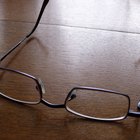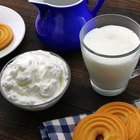
Many recipes, especially older ones, routinely begin by instructing cooks or bakers to scald their cream. This means heating it to a temperature near boiling, an important safety step in the days before widespread pasteurization. Although cream is now routinely pasteurized for safety, scalding it is still useful in some circumstances. It kills any bacteria that have recolonized the cream since it was pasteurized, and provides a useful opportunity to infuse the cream with flavors. Cream scorches easily, but there are several ways to heat it without damaging its flavor.
Step 1
Heat the cream gently in a heavy, wide-bottomed saucepan over low to moderate heat. It can take 30 minutes or longer for the cream to rise to a simmering temperature of over 180 degrees Fahrenheit, so be patient. Stir it frequently with a soft silicon spatula to prevent sticking and scorching. This is the best technique when you want to infuse spices or vanilla beans into the cream.
Step 2
Pour the cream into a double boiler and set it over a pot of boiling water. If you don't have a double boiler, improvise by finding a mixing bowl that will rest neatly on top of the pot of water. This indirect heat will eventually bring your cream to a simmer, but with much less risk of scorching.
Step 3
Measure your cream into a microwave-safe glass bowl or measuring cup, and place it in the microwave. Heat it at full power in one-minute increments, until it's hot to the touch. Stir the cream with a clean spoon and continue heating, 30 seconds at a time. When the cream begins to bubble, stop the microwave and remove the cream. Don't fill your bowl more than half-full, because if you overheat the cream, it will foam up dramatically.
Step 4
Steam the cream using the milk-frothing attachment of your cappuccino machine, or a standalone steam-type milk frother. This method is very fast, but provides minimal opportunity for infusing flavors.
Related Articles

How Many Calories Are in Cream of Wheat?

How to Bring Cream to a Boil

How to Harden Up Whipped Cream

How to Make Whipped Frosting Without ...

How to Fix Runny Boston Cream Filling

Why Does Cream Turn Into Butter?

How to Make Homemade Moisturizing Cream ...

How to Make Stiff Peaks in Whipped Cream

How to Remove Protective Coating

How to Use a Cream With Arginine

How to Thicken Cream Filling

Calories in a Tablespoon of Cream Cheese

How to Make Homemade Cream From Milk in ...

How to Remove Genital Hair Using Hair ...

Does Cream Spoil?

Why Does Some Alcohol Curdle Cream?

How to Prevent the Discoloration of ...

Nair Hair Removal Tips

How to Make Homemade Stretch Mark ...

How to Substitute Cream for Buttermilk
References
- The American Woman's Cookbook, Wartime Victory Edition; Ruth Berolzheimer
- On Food and Cooking: The Science and Lore of the Kitchen; Harold McGee
Tips
- If your cream scorches at the bottom of the saucepan, stop stirring and immediately pour it into a fresh pot or container. Taste the cream to test whether it has acquired a scorched flavor. If it has, discard it. If it still tastes good, continue heating it -- more carefully -- in a fresh pot or by an alternative method.
Warnings
- If your cream still looks and smells fresh but is on the verge of souring, applying heat will cause it to quickly curdle. Discard the curdled cream.
Writer Bio
Fred Decker is a trained chef and prolific freelance writer. In previous careers, he sold insurance and mutual funds, and was a longtime retailer. He was educated at Memorial University of Newfoundland and the Northern Alberta Institute of Technology. His articles have appeared on numerous home and garden sites including GoneOutdoors, TheNest and eHow.
Photo Credits
Jupiterimages/Stockbyte/Getty Images